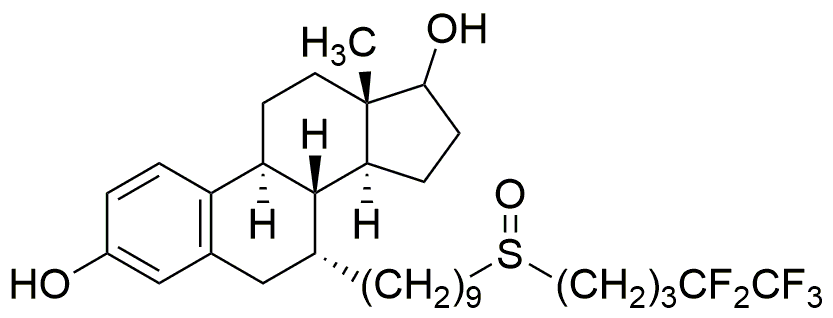Fulvestrant is widely utilized in research focused on:
- Breast Cancer Treatment: Primarily used as a therapeutic agent for hormone receptor-positive breast cancer, it helps in reducing tumor size and preventing cancer progression.
- Hormonal Therapy Research: Serves as a critical tool in studying estrogen receptor signaling pathways, aiding researchers in developing new hormonal therapies.
- Combination Therapy Studies: Often investigated in combination with other cancer treatments to enhance efficacy, providing insights into multi-drug resistance mechanisms.
- Pharmacokinetics and Pharmacodynamics: Used in clinical trials to understand its absorption, distribution, metabolism, and excretion, which is vital for optimizing dosing regimens.
- Biomarker Development: Plays a role in identifying biomarkers for treatment response, helping to tailor personalized medicine approaches for patients.
Informations générales
Propriétés
Sécurité et réglementation
Applications
Fulvestrant is widely utilized in research focused on:
- Breast Cancer Treatment: Primarily used as a therapeutic agent for hormone receptor-positive breast cancer, it helps in reducing tumor size and preventing cancer progression.
- Hormonal Therapy Research: Serves as a critical tool in studying estrogen receptor signaling pathways, aiding researchers in developing new hormonal therapies.
- Combination Therapy Studies: Often investigated in combination with other cancer treatments to enhance efficacy, providing insights into multi-drug resistance mechanisms.
- Pharmacokinetics and Pharmacodynamics: Used in clinical trials to understand its absorption, distribution, metabolism, and excretion, which is vital for optimizing dosing regimens.
- Biomarker Development: Plays a role in identifying biomarkers for treatment response, helping to tailor personalized medicine approaches for patients.
Documents
Fiches de données de sécurité (FDS)
La FDS fournit des informations de sécurité complètes sur la manipulation, le stockage et l’élimination du produit.
Spécifications du produit (PS)
Le PS fournit une description complète des propriétés du produit, notamment sa composition chimique, son état physique, sa pureté et les exigences de stockage. Il détaille également les plages de qualité acceptables et les applications prévues du produit.
Certificats d'analyse (COA)
Recherchez des certificats d'analyse (COA) en saisissant le numéro de lot du produit. Les numéros de lot et de lot se trouvent sur l'étiquette d'un produit, après les mots « Lot » ou « Lot de fabrication ».
Numéro de catalogue
Numéro de lot/série
Certificats d'origine (COO)
Ce certificat d'exploitation confirme le pays dans lequel le produit a été fabriqué, et détaille également les matériaux et composants utilisés et s'il est issu de sources naturelles, synthétiques ou autres sources spécifiques. Ce certificat peut être requis pour les douanes, le commerce et la conformité réglementaire.
Numéro de catalogue
Numéro de lot/série
Fiches de données de sécurité (FDS)
La FDS fournit des informations de sécurité complètes sur la manipulation, le stockage et l’élimination du produit.
DownloadSpécifications du produit (PS)
Le PS fournit une description complète des propriétés du produit, notamment sa composition chimique, son état physique, sa pureté et les exigences de stockage. Il détaille également les plages de qualité acceptables et les applications prévues du produit.
DownloadCertificats d'analyse (COA)
Recherchez des certificats d'analyse (COA) en saisissant le numéro de lot du produit. Les numéros de lot et de lot se trouvent sur l'étiquette d'un produit, après les mots « Lot » ou « Lot de fabrication ».
Numéro de catalogue
Numéro de lot/série
Certificats d'origine (COO)
Ce certificat d'exploitation confirme le pays dans lequel le produit a été fabriqué, et détaille également les matériaux et composants utilisés et s'il est issu de sources naturelles, synthétiques ou autres sources spécifiques. Ce certificat peut être requis pour les douanes, le commerce et la conformité réglementaire.

